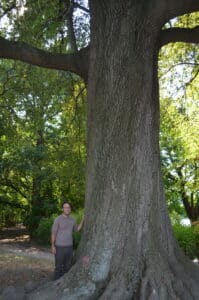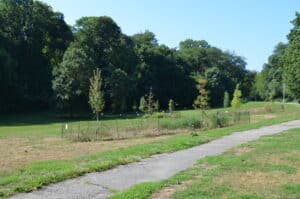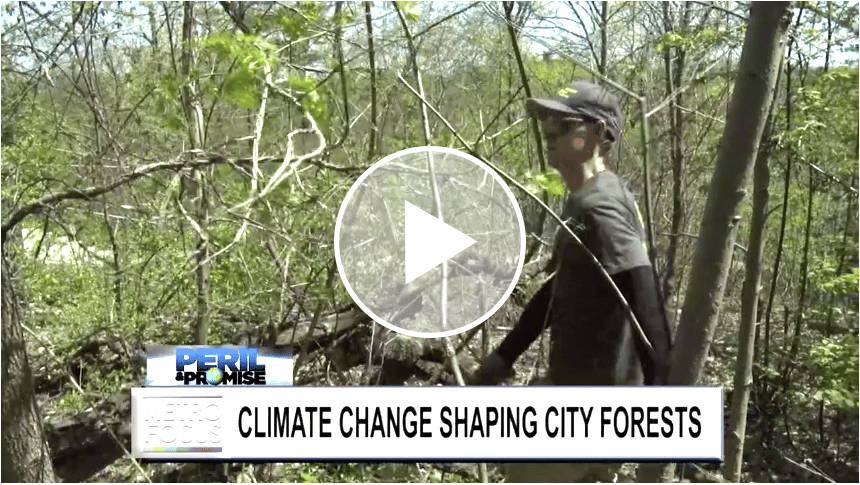What’s Blooming in Prospect Park?
April 2, 2024
April is National Native Plant Month and spring is in full bloom here in Prospect Park! You may have already spotted some early-blooming flowers like native ephemerals and ornamental perennial bulbs peeking through, and the change in season means even more flowers, vines, shrubs and trees will make our green oasis a spring wonderland in the coming weeks. Prospect Park Alliance’s Landscape Management team has been diligently preparing the park’s landscapes and natural areas for the season ahead and caring for the park’s countless plant species to make Brooklyn’s Backyard haven for wildlife such as pollinators and people alike during this vibrant season.
Take a look at where to find Prospect Park Alliance’s top spots for Spring blooms, from little-known park destinations to classic landscapes. While you explore the park’s blossoming meadows, forests, and more, remember to help your park thrive by admiring blooms from afar and leaving leaves, petals and berries on trees for the wildlife who depend on them to thrive. These plants help contribute to our healthy park ecosystem, ensuring that our beloved green space can flourish for generations to come for our community of people, plants and animals to enjoy.
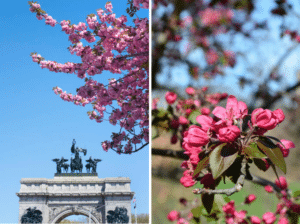
Pink cherry blossoms above Soldiers and Sailors Memorial Arch c. Martin Seck + Cherry Plum flowers in Grand Army Plaza c. Bianca Nelson
Grand Army Plaza is Prospect Park’s formal entrance, and features some of the park’s most ornamental flowers and trees. Among them, early-blooming cherry trees and daffodils are the first to arrive. April welcomes Eastern redbud and pink-flowering cherry trees that give way to the white Silverbells in May. As summer approaches, watch for the clustered bottlebrush buckeye flowers.
Imagination Playground Flower Field
Near Prospect Park’s Imagination Playground, a park destination beloved by kids and families for inspiring wonder and whimsy, you’ll find a native flower field complete with complimentary vibrant sights. Budding yellow Ovate Golden Ragwort is a must-stop for the park’s many pollinators. Eastern Red Columbine’s red and yellow tubular petals can be spotted. Plus, purple wood violets will be sprouting in mid-April along with the cheery bundles of Golden Alexander.
At Lakeside, the spring blooms attract park visitors and wildlife alike! Park goers who visit the greenroof at Lakeside in early spring will be able to catch the vibrant yellows, oranges and reds of Witch Hazel. As April advances, Lakeside receives a fresh coating of delicate white blossoms from the many Serviceberry, Chokeberry, Cherry laurels, and Foxglove Beardtongue that are buzzing with activity, as well as blooms of yellow from the Fragrant Sumac and Spicebush. Late spring brings with it a crescendo of flowering dogwoods and dewberries, and those with a keen eye might just spot a few of the subtle, deep purple blossoms of Lakeside’s paw paw trees!
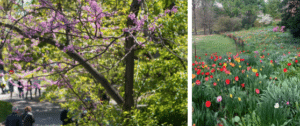
Eastern Redbud tree c. Martin Seck (left) + a bed of perennial ornamental bulb flowers in full bloom in Carmen’s Garden. c. Prospect Park Alliance (right)
The historic Litchfield Villa is a well-known destination for flower lovers. In April, tulips and Juneberries electrify Carmen’s Garden, located directly in front of the pre-Civil War-era mansion, heralding the arrival of warm weather. In May, blossoming crabapple and hawthorn trees paint the landscape in pinks and whites, while native perennials like Joe-pye-weed replace the fading ornamental tulips. Plus, don’t forget to head around to the back of the Litchfield Villa to spot the cream-colored flowering dogwood trees.

Light purple Creeping Phlox blooms in Prospect Park c. John Suhar + Magnolia blossoms by the Long Meadow c. Martin Seck
Passing through the Meadowport or Endale Arch in mid-April, visitors are welcomed by the peach and white bouquet of magnolia and dogwood trees that line the Long Meadow’s north end. The warmer weather brings out lilacs, as well as the hanging flowers of the yellowwood tree. Later in the season, enjoy the view under the shade of a flowering linden tree, and take in the sweet scent of the oakleaf hydrangea near the Picnic House.
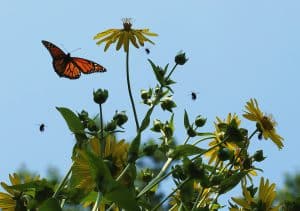
Pollinators making the most of spring in Brooklyn’s Backyard. c. Jabari Taylor
Prospect Park’s bustling natural areas provide a plentiful stop on any bloom-focused tour of the park. Head across Binnen Bridge, past the Nethermead and into the forest to find spicebush with its clusters of yellow flowers and small red fruits that are rich in nutrients for small birds that depend on this native plant. Pond edges are home to chokeberry, and American elderberry – which are native shrubs that will later feature berries that attract a variety of wildlife, making them instrumental in the health and diversity of Prospect Park’s thriving natural habitats.
Plus, keep your eyes peeled for the native bulbs of White baneberry, also known as “doll’s eyes,” and the airy flowers of False Solomon’s Seal in the lower midwood area of Prospect Park’s forest, along with flowering raspberry plants, and the rare and lively Pinxter azalea which will add a vibrant pop of color to the evergreening woodland areas. As you admire the forest blooms, remember to stay on mulched paths at all times to Be a Park Champion and help your park thrive with every visit.
Prospect Park is home to a few dedicated pollinator habitat gardens. In addition to Grand Army Plaza and Carmen’s Garden, Bartel-Pritchard Square features a variety of springtime blooms beloved by the birds, bees and butterflies that can be seen this time of year. Admire these buzzing beings from afar as they pollinate and take a look at the arching Carolina allspice – complete with unique maroon flowers that smell of strawberry anchor the native pollinator friendly beds. Plus, don’t miss the old-fashioned weigela, an ornamental shrub with beautiful trumpet-shaped lavender flowers.
